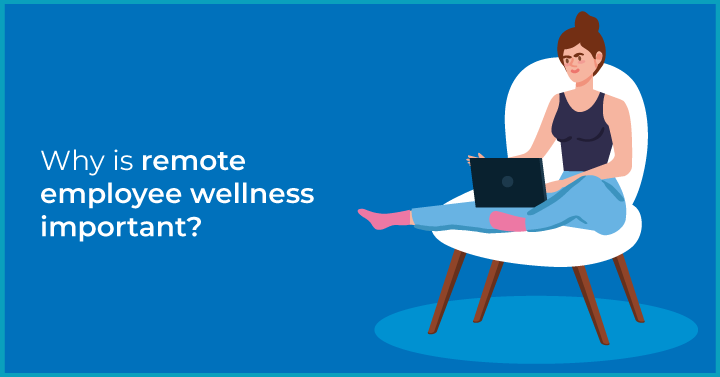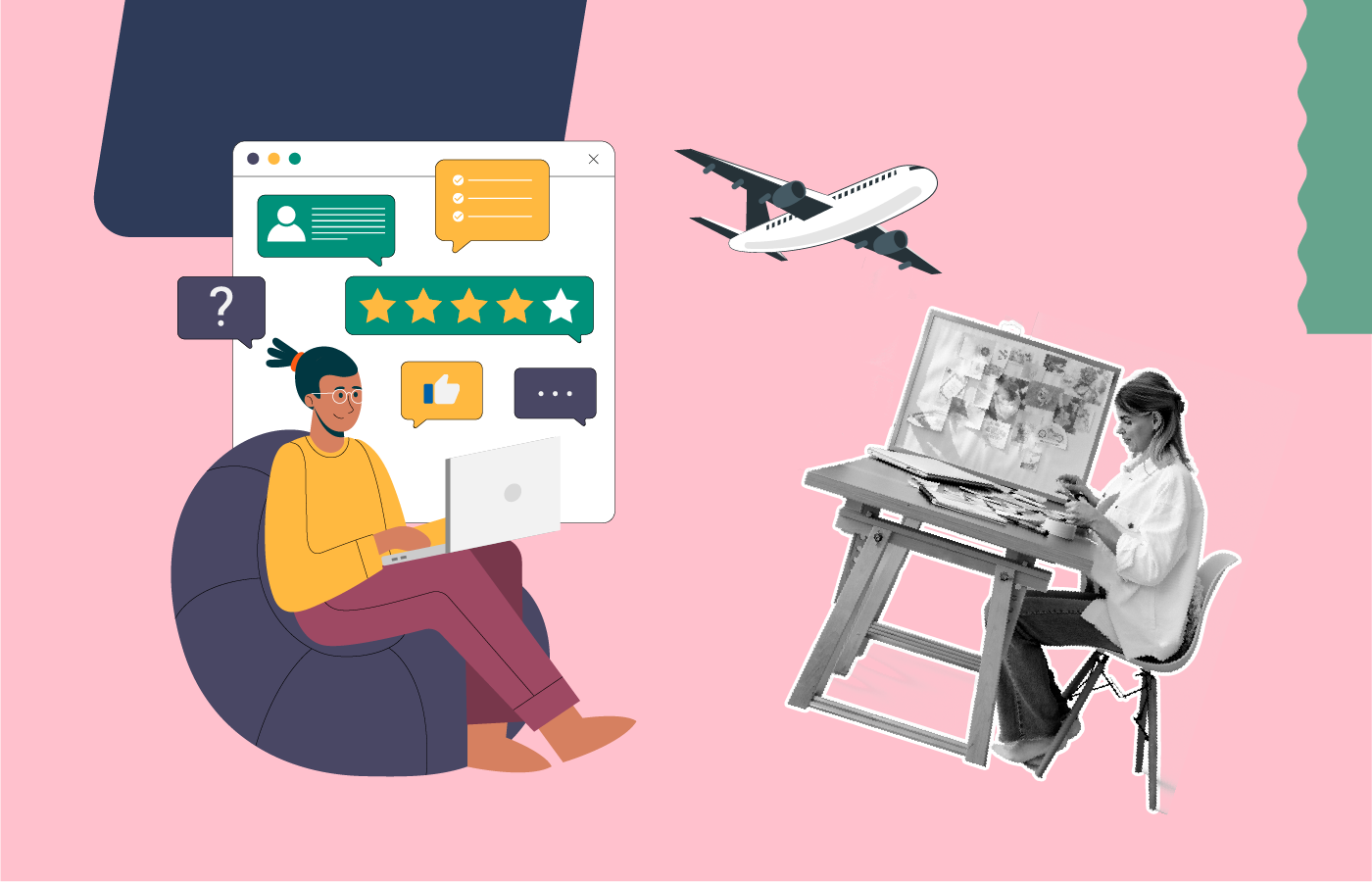Why is remote employee wellness important?

1) To prevent employee burnout
When working remotely, it's easy for the boundary between work and home to blur. This leads to remote employees often working longer hours,, derailing their work-life balance. On the flip side, a common household chore (or even answering the door for a parcel delivery) can interrupt one’s focus. Ultimately, this affects productivity, causes higher stress levels, and leads to burnout.Ideally, if you share an office space, it's much easier to notice when your colleagues are struggling. However, because you're working in a remote setup, extra effort needs to be taken to ensure that your employees are healthy — mind and body.2) To avoid loneliness and isolation
Because employees don't get to work in an office environment, they can start to feel isolated and lonely, especially if they are extroverted personalities who gain their energy from being around people. Human beings are social creatures by nature The removal of social stimulation at the workplace can lead to an increase in stress levels, negatively affecting their emotional wellbeing.10 ways to promote wellness activities for remote employees
1. Create an online mental health toolkit
 An online mental health toolkit is a curated list of resources to support employees who are experiencing any form of mental health issues. A comprehensive toolkit must include the following:
An online mental health toolkit is a curated list of resources to support employees who are experiencing any form of mental health issues. A comprehensive toolkit must include the following:- Links to Employee Assistance Programs, wellness information websites that operate in your geographical location, information guides regarding benefits, disability coverage, and wellness day-offs.
- Links to online mental wellness forums and communities.
- A list of online therapy or e-therapy options.
- A list of applications that provide general information and help manage mental health and lifestyle.
- A list of chatbot services such as Wysa and Woebot that support people with mental health problems like depression and anxiety.
2. Set up virtual connection circles
 People who work remotely often experience social isolation, and that's one of the reasons why they greatly value the opportunity to connect with others. Consider setting up virtual groups of 5-8 people — a safe space where employees can interact with each other about their lives, pets, changes in the company, or even the daily news. If you want to take this one step further, you can even hire a professional facilitator — someone who is experienced in mindfulness and personal development, to organize and monitor these sessions.Another great way to encourage employee wellness is to set up a 'virtual water cooler' using digital communication tools such as Slack or Skype. These digital channels allow your remote employees to interact and form personal connections, in turn, reducing loneliness and isolation.
People who work remotely often experience social isolation, and that's one of the reasons why they greatly value the opportunity to connect with others. Consider setting up virtual groups of 5-8 people — a safe space where employees can interact with each other about their lives, pets, changes in the company, or even the daily news. If you want to take this one step further, you can even hire a professional facilitator — someone who is experienced in mindfulness and personal development, to organize and monitor these sessions.Another great way to encourage employee wellness is to set up a 'virtual water cooler' using digital communication tools such as Slack or Skype. These digital channels allow your remote employees to interact and form personal connections, in turn, reducing loneliness and isolation.3. Establish boundaries between work and personal time
 A study conducted by the Digital Ocean in 2019 found that 82% of remote workers in the U.S. felt burnt out. One of the primary reasons that contributed to this was the lack of boundaries between work and personal time.It's true that remote employees can afford more flexibility. However, this doesn't improve their work-life balance. In fact, the increased flexibility makes it harder to escape work physically as it's always right there — at home. And that's why employees must be encouraged to have 'off-time' where they don't check-in with their team or respond to emails and instant messages.Also, encourage your employees to take five or ten-minute breaks during their workday to stretch their legs, take a quick walk around their house or simply rest. Doing so will ensure that when they return to their work, they are likely to be more motivated and productive. This will also dramatically improve their mental well-being.
A study conducted by the Digital Ocean in 2019 found that 82% of remote workers in the U.S. felt burnt out. One of the primary reasons that contributed to this was the lack of boundaries between work and personal time.It's true that remote employees can afford more flexibility. However, this doesn't improve their work-life balance. In fact, the increased flexibility makes it harder to escape work physically as it's always right there — at home. And that's why employees must be encouraged to have 'off-time' where they don't check-in with their team or respond to emails and instant messages.Also, encourage your employees to take five or ten-minute breaks during their workday to stretch their legs, take a quick walk around their house or simply rest. Doing so will ensure that when they return to their work, they are likely to be more motivated and productive. This will also dramatically improve their mental well-being.4. Implement employee assistance programs
 When working with remote employees, creating personal connections can be a challenge. After all, you don't get to stop by their desk every day and indulge in a friendly conversation. Unfortunately, this leads to remote workers often suffering in silence. This is where an Employee Assistance Program (EAP) can prove to be invaluable.The Employee Assistance Program is essentially a confidential service that caters towards helping employees with any issues that they may be impacting their wellbeing — both physical and mental. One of the primary advantages of EAPs is the fact that they aren't limited in what they can assist employees with. Child care, financial troubles, legal problems — the list is endless.And because EAPs are at no extra cost to employees, offering this kind of service can be extremely beneficial to remote workers who may not have the time or access to the right resources to address these needs.
When working with remote employees, creating personal connections can be a challenge. After all, you don't get to stop by their desk every day and indulge in a friendly conversation. Unfortunately, this leads to remote workers often suffering in silence. This is where an Employee Assistance Program (EAP) can prove to be invaluable.The Employee Assistance Program is essentially a confidential service that caters towards helping employees with any issues that they may be impacting their wellbeing — both physical and mental. One of the primary advantages of EAPs is the fact that they aren't limited in what they can assist employees with. Child care, financial troubles, legal problems — the list is endless.And because EAPs are at no extra cost to employees, offering this kind of service can be extremely beneficial to remote workers who may not have the time or access to the right resources to address these needs.5. Incorporate employee wellness day-offs
 Even though your remote team is working from home, they still need a break. For instance, some remote employees may be feeling under the weather but choose to work because they feel like a sick day isn't justified as they're already working from the comfort of their own home.Offering remote employees a certain number of 'wellness day-offs' or 'duvet days' will help them take a much-needed, guilt-free break from work. They can use the time to relax and recharge and come back to work, feeling more energised, motivated, and inspired. Offering wellness day-offs (and encouraging employees to avail them) as a perk will boost employee engagement and foster a positive work culture in the organization.
Even though your remote team is working from home, they still need a break. For instance, some remote employees may be feeling under the weather but choose to work because they feel like a sick day isn't justified as they're already working from the comfort of their own home.Offering remote employees a certain number of 'wellness day-offs' or 'duvet days' will help them take a much-needed, guilt-free break from work. They can use the time to relax and recharge and come back to work, feeling more energised, motivated, and inspired. Offering wellness day-offs (and encouraging employees to avail them) as a perk will boost employee engagement and foster a positive work culture in the organization.6. Offer virtual wellness activities
 A recent study conducted by FlexJobs showed that, on average, roughly 40% of remote employees are eager to attend virtual mental health activities offered through their workplace. These activities can range from meditation classes, workout classes, yoga sessions, or even webinars about mental health topics.There are a few different ways through which you can organise virtual wellness programs. Some of them include —
A recent study conducted by FlexJobs showed that, on average, roughly 40% of remote employees are eager to attend virtual mental health activities offered through their workplace. These activities can range from meditation classes, workout classes, yoga sessions, or even webinars about mental health topics.There are a few different ways through which you can organise virtual wellness programs. Some of them include —- Providing access to online meditation and yoga sessions
- Hiring instructors to conduct live, guided sessions for your remote workforce.
- Offering memberships to popular mental and physical health wellness applications like Headspace, Calm, and Peloton.
- Sponsoring and live-streaming monthly seminars and interactive Q&A sessions on employee wellness topics like the importance of sleep, burnout, nutrition, etc.,
7. Provide reimbursement or subsidisation for employee fitness activities
 Different people enjoy different health activities. For instance, not everyone wants to take up the 'daily plank' challenge or dance to hip hop music in their living room. And that's why, possibly an alternative to the previous suggestion, offering reimbursement or subsidisation towards remote employee wellness activities is a genius idea!For instance, you can consider providing reimbursement for gym memberships, dance classes, or even martial arts sessions. You can also offer them access to paid online fitness classes, discounted gym memberships, free activity monitors, and online physio assessments to ensure that their remote setup is as conducive as possible.Another option is to simply offer employees an annual wellbeing bonus that they can use towards their wellness — both physical and mental. People could choose to use the money for gym memberships, meditation apps, or even art classes.By offering a wellbeing bonus, reimbursement, or subsidisation, you're making employee wellness activities accessible to your entire remote team — irrespective of their situation. Above all, you're showing them that you care.
Different people enjoy different health activities. For instance, not everyone wants to take up the 'daily plank' challenge or dance to hip hop music in their living room. And that's why, possibly an alternative to the previous suggestion, offering reimbursement or subsidisation towards remote employee wellness activities is a genius idea!For instance, you can consider providing reimbursement for gym memberships, dance classes, or even martial arts sessions. You can also offer them access to paid online fitness classes, discounted gym memberships, free activity monitors, and online physio assessments to ensure that their remote setup is as conducive as possible.Another option is to simply offer employees an annual wellbeing bonus that they can use towards their wellness — both physical and mental. People could choose to use the money for gym memberships, meditation apps, or even art classes.By offering a wellbeing bonus, reimbursement, or subsidisation, you're making employee wellness activities accessible to your entire remote team — irrespective of their situation. Above all, you're showing them that you care.8. Implement gamification strategies
 In a nutshell, gamification is the application of game elements in a non-game context. The theory behind gamification strategies is that people naturally thrive in competitive setups and enjoy the rewards and recognitions that come with their accomplishments. This is extremely helpful in distributed or remote teams, where employee engagement is key.‘The only way to do great work is to love what you do’ – Steve JobsRecognition of one’s efforts and achievements triggers a positive emotional response for the employee which in turn leads them to like their work and make it less stressful. Much like games introduce trophies and achievement awards for completing certain tasks, certain workplace processes can be gamified to the same effect. A few examples for your consideration
In a nutshell, gamification is the application of game elements in a non-game context. The theory behind gamification strategies is that people naturally thrive in competitive setups and enjoy the rewards and recognitions that come with their accomplishments. This is extremely helpful in distributed or remote teams, where employee engagement is key.‘The only way to do great work is to love what you do’ – Steve JobsRecognition of one’s efforts and achievements triggers a positive emotional response for the employee which in turn leads them to like their work and make it less stressful. Much like games introduce trophies and achievement awards for completing certain tasks, certain workplace processes can be gamified to the same effect. A few examples for your consideration- An employee can be given a ‘Social Butterfly’ award if he is able to find out the favourite hobbies of his colleagues (beyond his immediate team).
- Employees who regularly update their photo on the company portal can be given a ‘Photogenic’ award.
- Employees who are still clocked-in/active past official working hours can be awarded a ‘Burning the Midnight Oil’ badge.
9. Implement frequent employee check-ins
 In a recent study conducted by Epson, 48% of remote workers admitted to feeling lonely, and 46% claimed that working remotely can be isolating. And yet, not many talk about it.That's why it's crucial to schedule an E-tête-à-tête (private conversation) with your remote employees, at least on a bi-weekly basis. These regular check-ins that are a part of healthy remote management, will act as an opportunity to build rapport and trust, discuss goals, progress, struggles, and any development opportunities.But most importantly, during these meetings, make an effort to really listen. Are your remote employees speaking positively about their work? Are they experiencing pressure? Do they feel unappreciated? By really listening to what's being said, you can gauge how your employees are feeling — whether they're unhappy, stressed, or even isolated.A complementary exercise as a way to check-in with your employees is to create an anonymous survey — one that asks targeted questions, to assess the levels of anxiety, pressure, and stress in your organisation. This will give you a clear picture of the mental wellness of your remote employees, and you can then implement measures to promote a healthy work environment, if needed.
In a recent study conducted by Epson, 48% of remote workers admitted to feeling lonely, and 46% claimed that working remotely can be isolating. And yet, not many talk about it.That's why it's crucial to schedule an E-tête-à-tête (private conversation) with your remote employees, at least on a bi-weekly basis. These regular check-ins that are a part of healthy remote management, will act as an opportunity to build rapport and trust, discuss goals, progress, struggles, and any development opportunities.But most importantly, during these meetings, make an effort to really listen. Are your remote employees speaking positively about their work? Are they experiencing pressure? Do they feel unappreciated? By really listening to what's being said, you can gauge how your employees are feeling — whether they're unhappy, stressed, or even isolated.A complementary exercise as a way to check-in with your employees is to create an anonymous survey — one that asks targeted questions, to assess the levels of anxiety, pressure, and stress in your organisation. This will give you a clear picture of the mental wellness of your remote employees, and you can then implement measures to promote a healthy work environment, if needed.10. Set SMART and realistic goals
 Remote employees, just like your on-site employees, must be assigned SMART goals. SMART (Specific, Measurable, Achievable, Relevant, and Time-bound) goals are carefully planned, clear, and trackable objectives that ensure that your remote workers aren't stretching themselves thin while trying to meet deadlines and submit deliverables.On the one hand, if your remote employees don't have any goals to work towards, they're going to feel unmotivated and unproductive. On the flipside, goals that verge on the impossible will stress your employees and disengage them, in turn, creating a toxic work culture. And that's why finding the right balance is key to the mental wellness of your remote employees.In a modern, agile organisation, the best way to set SMART goals is to consider each employee's strengths and weaknesses. Let your remote team know that if they are struggling with their workload, you'd be more than happy to revisit their goals and update or revise them. This approach will reduce employee stress, increase employee satisfaction, and prevent burnout.
Remote employees, just like your on-site employees, must be assigned SMART goals. SMART (Specific, Measurable, Achievable, Relevant, and Time-bound) goals are carefully planned, clear, and trackable objectives that ensure that your remote workers aren't stretching themselves thin while trying to meet deadlines and submit deliverables.On the one hand, if your remote employees don't have any goals to work towards, they're going to feel unmotivated and unproductive. On the flipside, goals that verge on the impossible will stress your employees and disengage them, in turn, creating a toxic work culture. And that's why finding the right balance is key to the mental wellness of your remote employees.In a modern, agile organisation, the best way to set SMART goals is to consider each employee's strengths and weaknesses. Let your remote team know that if they are struggling with their workload, you'd be more than happy to revisit their goals and update or revise them. This approach will reduce employee stress, increase employee satisfaction, and prevent burnout. Interested in Virtual Team Building Events?
Interested in Virtual Team Building Events?




















